Intermediate forsythia: types, care, reproduction and use in landscape design
Forsythia is a shrub or tree that belongs to the olive family. The branches are upright, reaching a height of up to 4 meters. The leaves are simple, oval, serrated. Leaf length can reach 10 cm. Forsythia flowers are bright yellow and consist of 4 petals, up to 3 cm in diameter. The advantage of these bushes is that flowering begins immediately after winter. Flowers appear first on the branches, and after flowering bright green leaves appear. The flowering period lasts almost a month.
Content:
Types of forsythia
Forsythia is an unpretentious and fast-growing plant.
In favorable conditions, the branches can lengthen up to 50 cm per year.Does not require special care and excellent takes root in almost any soil.
Hanging forsythia:
- Its homeland is China.
- It is a shrub with branches reaching 3 meters in height.
- Branches, olive-colored, grow arched, and the bush itself has a spreading shape.
- Flowers are bright yellow, four-petal in diameter reach 2.5 cm. Flowers grow singly along the branches or grow in inflorescences of 3-4 pieces.
- Leaves are oval in shape with jagged edges.
Intermediate forsion:
- This plant has this name, since this species is an intermediate hybrid between the dark green and wilted forsythia species.
- The height of this bush reaches 3.5 meters.
- Its branches are straight and drooping, strongly spreading.
- The leaves are oblong, oval, serrated at the edges, the length can reach 10 cm.
- Flowers of golden yellow color are collected on branches in several pieces together.
- This species is hardy and drought tolerant.
- Flowering begins already in the third year of life. The flowering period begins in late April and lasts for 20 days.
Forsythia ovoid:
- The shrub height reaches 2 meters.
- Spreading branches, on which golden flowers are located.
- The leaves are elongated, oval, pointed at the ends.
- This species does not bloom for a very long time, about 2–2.5 weeks.
- This species is beautiful not only in spring but also in autumn.
- During this period, forsythia leaves become orange and purple in color.
- Forsythia ovoid tolerates winter and dry summers well.
- It grows fast enough. Propagated by seeds, layering and cuttings.
- Often used in gardens and parks.
European forsythia:
- The bush has a spherical shape thanks to the thick branches, the height of which reaches 2 meters.
- The bush itself can grow up to 3 meters in diameter. The flowers are lemon-colored and large enough.
- Flowering begins in April, flowers appear several days earlier than leaves.
- The leaves are light green in color, reaching a length of 8 cm.
- A fairly durable plant, the age can reach 70 years.
Forsythia is dark green:
- Homeland is China, where it grows on the mountain slopes.
- These bushes have a dark green color on the branches, which is why this type of forsythia got its name.
- The bush itself grows up to 3 meters.The plant blooms in a gentle light green color, and the flowers are collected in 3 pieces in a bunch or are arranged singly on the branches.
- The leaves are elongated, at the ends in the upper part there are notches.
- This species is more thermophilic than the rest, but it is also drought tolerant.
- Distributed in southern, coastal countries.
Forsythia Giralda:
- Its homeland is China.
- Forsythia bushes of this species reach a height of 2 meters.
- It has straight and curved branches that are yellow-brown in color.
- The leaves are elongated, dark green.
- This plant blooms in May, the flowers are light yellow in color and slightly twisted petals.
- It tolerates winter and frost well.
Forsythia care
Forsythia bushes require annual pruning.
With proper pruning, the bush becomes thicker and more abundant flowering. In young shoots, a little upper part is cut off. Older branches are cleaned more thoroughly. If the trim is decorative, then only those branches are deleted that go beyond the required form. In the spring, immediately after wintering, all dry branches are removed. Pruning goes to healthy living wood.
Pruning after flowering is also necessary, in which a smaller part of the faded branches is removed.
For the winter, the bush must be mulched:
- To do this, you can use fallen leaves from a bush or straw.
- In areas where winters are more frosty, long branches are also insulated. They are bent to the ground, fixed and insulated.
- It is important to control the opening of the plant in early spring, with a late opening, the insulated roots and branches can support, and the plant can get sick.
- Also, after opening the bush, it it is necessary to feed with humus and mineral fertilizers.
Watering forsythia is necessary in moderation and only during dry periods. The plant tolerates heat well, but reacts very poorly to excess moisture and waterlogged soil. Resistant to diseases and pests.
Reproduction of forsythia
Reproduction of forsythia occurs in the autumn with the help of cuttings and layering.
Much less often, reproduction is carried out using seeds. The easiest way for this plant is to propagate by layering. Branches that fall from the bush and come into contact with the ground root well on their own. You can also root the required branches yourself. To do this, you need to cut the bark a little in the place where the branch will be covered with earth. Next, bend and fix the branch to the ground and sprinkle the incised area with earth, about 10 cm. This operation is carried out in the fall, and in the spring you can cut off the layers from the mother bush. Such a young bush can bloom in a year.
It is also easy to propagate the plant by cuttings:
- Young cuttings are cut in June, woody in autumn.
- For rooting, they are planted in fertile soil and must be insulated for the winter.
Ready-made seedlings with good roots are planted in the autumn.
For this, sunny places are chosen in the garden, closed from the wind. You can also plant a bush in partial shade. It is better to plant young bushes in prepared fertile soil, consisting of humus, sand and leafy soil. Planting pits are made shallow, up to 70 cm and at a distance of up to 2.5–3 meters, depending on the type of forsythia. At the bottom of the hole, it is preferable to make drainage, then a bush lies in it and sprinkled with prepared soil. The ground around the bush is well trampled and watered abundantly.
Application in landscape design
Forsythia is very often used in design of gardens and parks... Due to the fact that in spring it blooms first among all bushes and trees, and in winter it is covered with bright purple and yellow-orange leaves, it is often planted singly. The forsythia bush also looks very impressive in combination with other bushes of a similar size.
Very often in country houses, this plant is used as a hedge.
Designers are very fond of using forsythia bushes, as it does not require special care and frequent pruning, is drought-resistant and looks great in any composition.
More information can be found in the video.



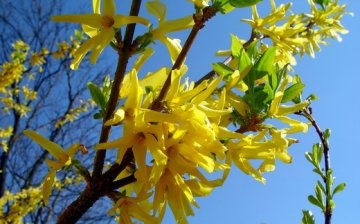
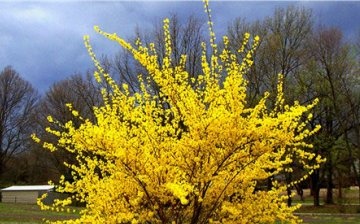

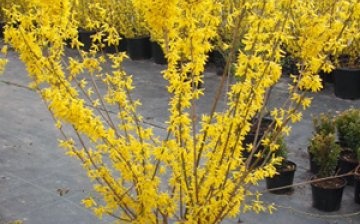

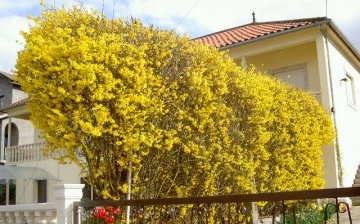






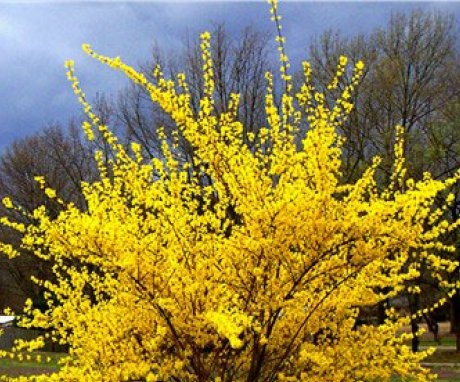
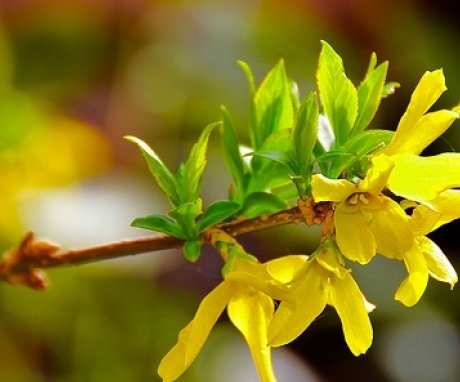
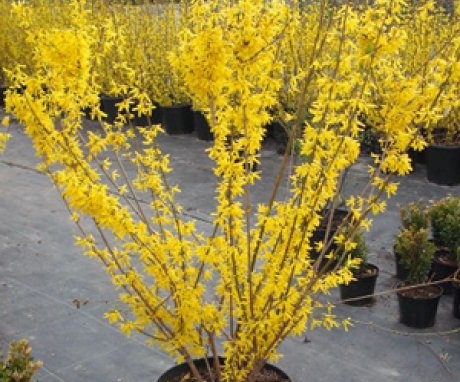
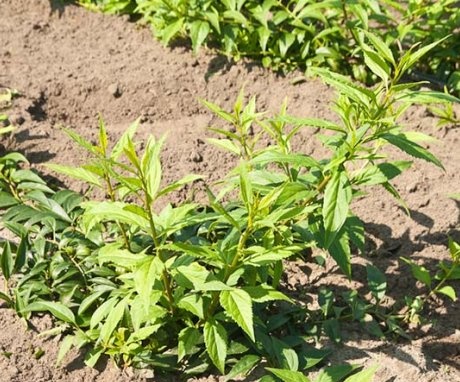
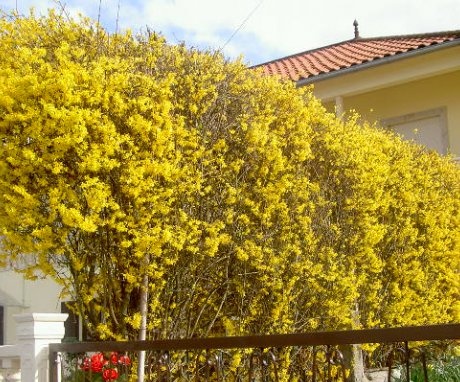
I have a very nice forsythia among conifers, and a single one. In summer, when it does not look very impressive, it dissolves against the background of junipers and yews.